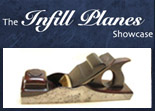Interview With Plane Maker Malcolm Macpherson
To the novice, planemaking may appear to be full of secrets, hidden pitfalls and mystique. Some feel that it’s in a realm similar to violin making or gilding, practiced only by a few select “masters” who have learned the ways and guard these secrets closely. The reality, however, is far from this.
Planemakers are, in my experience, very open about what they do and how they go about it. I find that they are quick to help with advice, ideas and practical experience on basically anything, and I can honestly say that i’ve never met a planemaker who is secretive to any great degree and, over the years, I have met and corresponded with quite a few planemakers.
It’s good to see that the new makers are continuing this “tradition” of open-mindedness, and recently I was able to ask two planemakers, Philip Marcou and Malcolm Macpherson, some questions about starting out with making hand planes. We had Philip’s interview a week or so ago but, this time, it’s Malcolm’s turn to tell us about how he got started in planemaking, how he does it, what he’s made and what’s next up on the horizon.
Malcolm Macpherson graduated from the University of Canterbury in New Zealand in 1968 and started working as a field hand at Kennecott Copper Corporation in Salt Lake City, Utah. Traveling must have been in his blood, for after Salt Lake City Malcolm soon found work as an exploration geologist in Papua-New Guinea, Australia, Indonesia, the Pacific Islands and New Zealand throughout the early 1970’s.
In 1979 Malcolm decided to take a different path and moved to Wales in the U.K. to became a furniture maker, twice winning a Welsh National Eisteddfod craft/design award during his time there. Whilst in Wales, he also organized community and commercial exhibitions and promoted several events on the side.
In 1986 Malcolm moved back to New Zealand and continued with his furniture making business. It was at this stage where he found himself becoming involved with pioneering desktop publishing and soon established himself as the owner, and editor, of “The New Zealand Woodworker” magazine (previously “Touch Wood”). Malcolm continued his work as a community agent and local government consultant and was elected to the Te Poutini Polytechnic establishment council in the late 1980’s.
Nowadays he is the Mayor of Central Otago District in New Zealand, but Malcolm still finds time to do a bit of woodworking and, fairly recently, planemaking.
H.C. – How did you get involved in making hand planes?
Malcolm Macpherson – It’s Krenov’s fault. When his books first appeared I was struggling to make a living as a furniture maker in Wales, and his ideas resonated with me, as they did with woodworkers all around the world way back then. I loved the idea of his organic-looking bandsaw-shaped smoothers, but never got around to making one. Then, years later, as I began to set up a recreational shop with commercial capacity here in New Zealand, one of the first things I built was a long Krenov-style jointer with Hock irons. I was making a table, and didn’t then have the machinery, so I joined-up the boards by hand with my purpose-built 24 inch oak woodie. From there it was a couple of rosewood block planes, a matai and padauk smoother… and then, why not a real plane?
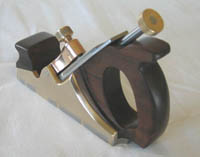
H.C. – Was it difficult getting information? What were your main sources?
Malcolm Macpherson – I can’t really remember now! I went to the internet, and Taunton’s Fine Woodworking forums, and dragged out all the tool-making articles from my collection of woodworking magazines, and bought a copy of Kingshott’s book (Making and Modifying Woodworking Tools). I read everything I could find, but still haven’t seen a number of the books that people usually recommend.
I guess my conclusion about “the literature” is that its not actually much use. The best thing to do is get some metal, or a kit, and have a go!
H.C. – Was the transition between wanting to make a plane and actually making one a difficult choice? Did you procrastinate for a while, or did you just jump in and do it?
Malcolm Macpherson – I just had a go. I suppose I began at the beginning, with laminated Krenov-style woodies, which are quite easy to make, then worked my way towards a kit, and then graduated to my own fabrications. People who are fully occupied working wood for a living may have difficulty finding the time to make their own tools, but if my experience as a recreational woodworker/toolmaker is any guide, finding the time is well worth it.
H.C. – Did you have a mentor, or someone who you looked up to for inspiration and/or direction?
Malcolm Macpherson – Not really. I admire the work of the modern makers, and chatted a lot via email and the on-line forums with people like Philip Marcou (also in New Zealand). I’m a long way from any other craft woodworkers, let alone tool-makers, so I’ve had to go it alone.
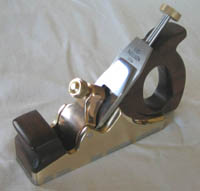
Karl Holtey sets the standard for engineering perfection, as far as one can tell from pictures and reputation, and Wayne Anderson is highly inventive and “artistic”. I’ve looked long and hard at the work they’ve published.
H.C. – What styles are you partial to, design wise? Traditional infills or the Stanley/Bailey style planes?
Malcolm Macpherson – The style I like the most is typified by the combination of sweeping, decorative lines and sharp transitions of the traditional Scottish infills. I’ve got a big poster-sized print of one pinned to my wall as inspiration.
My goal is to develop a style, a “brand” that’s distinctively mine. I love what Wayne Anderson is doing, greatly admire Karl Holtey’s work, and the Sauer and Steiner tools are very cool. Here in New Zealand, Philip Marcou is an emerging maker with enormous skill and promise. And then there’s HNT Gordon, Larry Williams, and a growing stable of other elite makers.
This may sound pretentious, but my goal is to make infill planes that are the equivalent of the baroque creations that the guys from Orange County Choppers make! Thomas Lie-Nielson and Larry Williams can make the gold-standards on the production side, I’d love to be able to make one-off showpieces (someone recently called this “shelf candy”) that look cool and work beautifully! I’m not good enough (yet), but give me a few more prototypes, and lots more practice, and I might be!
H.C. – What materials do you use for making your planes?
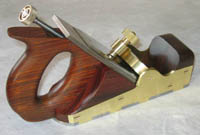
Malcolm Macpherson – The first metal plane (a little palm-sized block plane) was made from scrap — a piece of quarter inch mild steel and some brass bar scrounged free from a local auto reconditioner, infilled with lignum vitae from my wood store, with a recycled brass knob for the lever cap, and a spare Hock iron used bevel-up. I made this one as practice while I waited for my Shepherd kit to arrive.
My little 01 size smoother was made from a scrap of quarter inch stainless steel plate, again scrounged from a local engineer, and some recycled brass bar.
Now I use gauge plate — precision dimensioned tool steel — for the soles, but brass is hard to buy new where I live, so I’m still using recycled brass sheet and bar.
For infill I’ve used lignum vitae, cocobolo, Australian desert acacia, and Indian rosewood. I’m searching for some southern rata, a New Zealand native that finishes a deep beef red and is very hard and heavy. Difficult to find, though!
H.C. – Is it difficult or costly to get materials?
Malcolm Macpherson – Steel is easy, but expensive. Has to come from Christchurch, a six-hour drive away, so shipping can be as much as the purchase price. I just have to telephone and it arrives a couple of days later. Brass and bronze is more difficult. I’ve just taken delivery of a lump of bronze (for lever caps) that’s about three by four inches and a foot long — weighed 24 kg (what’s that — about 52 pounds?). Sold to me by a dealer in Christchurch for about $NZ 200 plus freight. I’ll get a dozen or more lever caps from that piece — chopped off like slices of bread. Brass is still a problem!
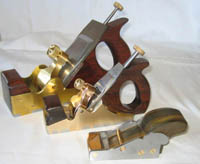
H.C. – Do you use machines to cut the dovetails or do you do them by hand?
Malcolm Macpherson – I started doing it entirely by hand. I know the professionals use milling machines, but I don’t have one. I either stick a paper pattern onto the metal and cut up to the line — just like cutting wood — or I mark the joints directly onto the metal. I have a little Metabo angle grinder, a really nice machine, and I’ve begun to use the new ultra-thin cut-off disks (metric sizes here — sold as 1 mm). With my Metabo I can cut freehand to within a 32nd of the line, and hog out the waste, quite quickly.
The most difficult part of a dovetail in metal is the long “land” between the pins. If these are not dead level along the while length, the joint will be gappy, and the gaps will show along the side of the plane! I’ve developed a technique that involves ganging the two brass sides together, cutting most of the waste away with my bandsaw, and then mounting the sides in a jig and milling the lands with my router. Bits of brass go everywhere! But, I get a dead level, square and true joint. I’m working on a twelve inch panel plane at the moment, with little thin pins and long tails, and the joints are perfect. Unlike a metal-working mill, this is also quick!
There’s still some hand work — filing carefully into the corners of the pins, although I’m working on a technique for that – but I quite enjoy it, and it goes quickly.
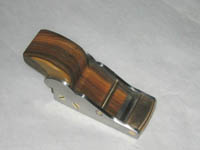
The other labour and time-saver is a cheap Taiwanese belt and disk sander Once the peening is done, the sander removes the excess metal really quickly.
H.C. – What other tools and equipment do you use for making planes?
Malcolm Macpherson – Other than my Metabo angle grinder, bandsaw and sander, it’s just about all hand tools. I’ve spent quite a lot of money on files! One of the neat things about the metalwork involved in making planes is that you don’t need a lot of gear. I do have quite a good wood shop, with all the usual machines. You need a metal-working vice, a small anvil (I use the flat anvil that’s part on my cheap Chinese vice), a peeing hammer, a good collection of sharp files… most people will have most of what they need in their shop already.
H.C. – You’ve built a couple of planes from Shepherd kits. Would you recommend that new planemakers who are starting out should consider the option of kit planes?
Malcolm Macpherson – Depends how experienced you are as a metal-worker. If you’re new to tool-making, as I was, and need to learn as you go, a kit is a great way to start. The general opinion around the community is that Shepherd kits are the best, by the way — their production standards are excellent, and improving all the time.
The major benefit of starting with a kit is that you get to produce a really good plane without too much risk. Having that cool tool attracting attention in your shop, and doing the business for you day after day, will almost certainly inspire you to try another kit, or make your own.
H.C. – Did you have any difficulty peening the dovetails? Do you have any tips or tricks that you’ve picked up?
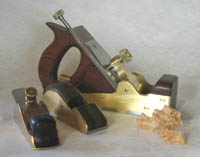
Malcolm Macpherson – Peening is one of the things that people worry about a lot before trying, then wonder what they were worried about when they’ve had a go! The key is tap tap tap, not whack whack. Peening is a gentle art! I’m always impressed by how far you can move metal, and how big the gaps are that you can fill. Peening is the part of making a plane I enjoy most. Perhaps there are some blacksmith’s genes in my background!
Tricks? Well, it’s not original to me, but one thing worth doing is masking-off so you don’t ding up the workpiece with wayward hammer blows. Cut a hole in a thin piece of steel (a soda can produces suitably thin material, as does shim stock) and use this to protect the surrounding metal. But you’ll find that the skill to hit the sweet spot, and just the sweet spot, comes quickly. Also, you need a good solid anvil. The last thing you want is to have the work bouncing all over the shop.
I’ve developed a technique for clamping the sides and sole together around a wooden buck so that when I begin to peen, the joints are already closed and tight, and the flowing metal just has to lock the parts together.
H.C. – Do you make your own adjusters?
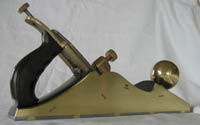
Malcolm Macpherson – No. But that’s next on my list. I’ve bought a Ray Iles “Norris-style” adjuster, and a few Classic Planes single-thread versions — all from the UK. I used a cut-down Classic Planes adjuster in my 01 size smoother. The twin-thread adjuster that came with my Shepherd kit is the best I’ve seen. If money was not a consideration, I’d use Holtey adjusters. I haven’t seen one, but by all accounts they are the gold standard in engineering, fit, and finish. The photographs are certainly impressive.
H.C. – As a politician your job has many demands, taking lots of ideas and opinions into consideration and coming up with the best solution. It’s in stark contrast to the more “laid back” pursuit of planemaking. Having said that though do you feel that the skills used in your day job compliment your planemaking in some way?
Malcolm Macpherson – No, there’s not much cross-over at all. That’s one of the reasons I enjoy getting into my shop and using my hands! I’ve heard people call taking a day off work a “mental health day”, and that’s what shop time is for me. I can switch off (literally — the phone stays in the house) and just focus on shaping and polishing metal and wood. I always feel better for it!
H.C. – What blades do you use for your planes. Do you make them yourself or use aftermarket blades?
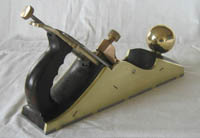
Malcolm Macpherson – I buy in blades. Making and hardening blades is something I don’t have any ambition to do. Also, there are a number of really good aftermarket options, including Hock and Lie-Nielson (my favorite).
H.C. – How many planes have you made? What kinds of planes were they?
Malcolm Macpherson – In total, about a dozen. Wooden and metal. Ranging in size from a tiny mouse-shaped block plane in lignum vitae to a 24 inch smoother in oak. In metal, I’m currently building number five — a chopper-inspired 12 inch panel plane with a 2 and 5/8 inch Clifton iron. I have a couple more to build to complete my set — although I may draw the line at a metal jointer!
H.C. – Do you see yourself possibly becoming a specialized or “limited edition” plane maker eventually? By this I mean selling hand-made planes to collectors and users?
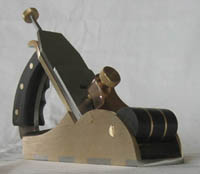
Malcolm Macpherson – Yes I do, but with reservations. There’s no point trying to compete with the manufacturers, and in any case the better commercial planes are very good. There is an emerging international market for collector-grade bespoke planes, and that’s where people like Holtey, Saur and Steiner, Wayne Anderson and Philip Marcou, and a few others, fit in. If I do go on to offer planes for sale, that’s where I’ll position myself.
H.C. – What do you think of the internet as a planemaking resource?
Malcolm Macpherson – For people like me, who work in isolation and are mostly self-taught, the internet is the only option. There are a few good books, although I haven’t seen them all, but if you have a problem, and need help, the internet is a marvelous resource. There are discussions on making, using, fettling and restoring planes going on all the time — especially on the Fine Woodworking site, and here at Handplane Central.
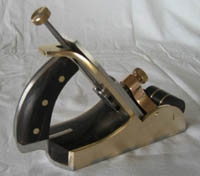
H.C. – What’s next on the agenda? What types of planes are you interested in making and what ideas do you want to incorporate?
Malcolm Macpherson – After the panel plane, I’m going back to where I began, to re-work my approach to palm planes. Before I began making my own, the plane I reached for first, and most, in my shop was a little Bristol Design block plane. For that reason the first metal infill plane I made was a sort of computer mouse shape with a wooden lever cap that looks OK and functions well (I don’t like it though because my dovetailing was rough and the mouth is a bit wide), and that’s an idea I want to follow up. The Bristol plane works well, but doesn’t sit comfortably in my hand.
The new Swiss-made Rali planes are interesting, especially the small shoulder and block planes — tall, square, very post-modern looking with pierced sides and exposed bolts and screws. There’s a place for reproduction planes, but I’m more interested in pushing things a bit!
In a recent on-line discussion, Larry Williams made a point about modern manufactured planes, noting that the designers “missed many of the more subtle features” of traditional wooden planes. “Tall sides for a tactile plumb and level indication is one of the more important features they missed”, he went on to say. That’s a very interesting observation, especially in the context of the Rali planes form factors, and one that I’ll be thinking about when I sketch my version 2 mouse plane.
To check out more of Malcolm’s hand planes, click here.






